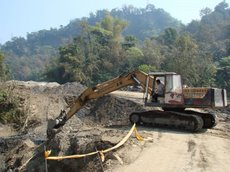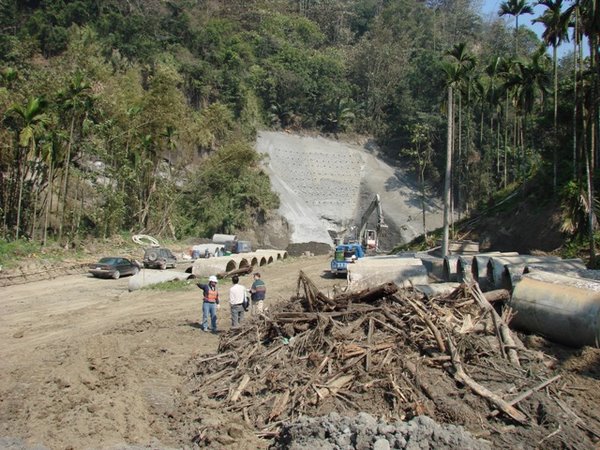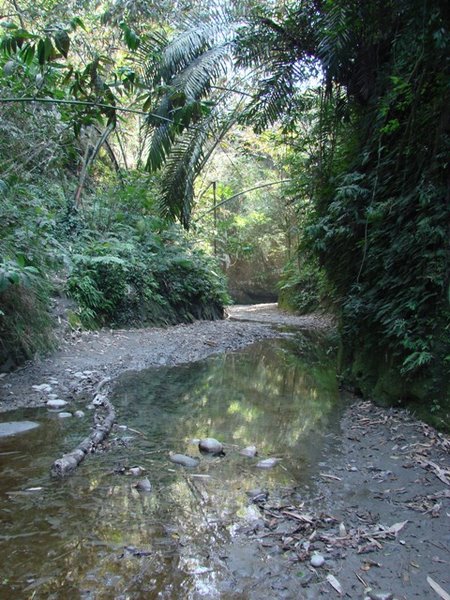
Hushan Dam will largely supply water for the further development of heavy industry on Taiwan's west coast. The Formosa Steel Plant is one such project. Below is an update on the EIA process concerning this project.
Taipei:-26 September 2007
The seventh term of the Environmental Protection Administration's (EPA) Environmental Impact Assessment (EIA) Commission met today to discuss, in a “pre-meeting meeting”, the proposed Formosa Steel Plant, which the developer, Formosa Plastics, would like to see built next to its existing petrochemical industrial complex that lies along side the Jhuoshui River estuary between Yunlin County and Changhua County in central Taiwan.
An official from Taiwan’s EPA began by summarizing its version of the procedural history of the case. The first committee meeting on the case took place in March 2006. One year later, during the fourth meeting of the review committee, on 19 March 2007, the committee recommended that the development go into a second phase assessment. However, that recommendation never made it to the plenary commission. According to the EPA, the developer requested an opportunity to “submit additional materials”. Breaking with its normal procedure (although not unprecedented) of referring the review committee’s decision to the plenary commission, the EPA staff granted the request with a deadline of 31 May 2007.
As the deadline loomed, the EPA continued, the developer stayed the proceedings by filing an objection to the presence of five commissioners on the review committee. Claiming that the commissioners are “quasi-public officials” and that these five in particular had expressed prejudice against the development. Thus, according to the Administrative Procedure Act (APA), the five should be disqualified from further participation in the proceedings. The EPA accepted the complaints agreeing with the position that the commissioners are public officials for purposes of the APA, but referred the other issues to the Ministry of Justice (MOJ). This effectively ensured that the five commissioners in question would have no opportunity to participate in the plenary commission’s discussion of the case as under the APA such questions must be cleared up before the proceedings can continue.
The EPA has not announced the Ministry of Justice’s decision in the matter, and environmental groups have been unable to discern whether the MOJ ever made a determination as to the disqualification of commissioners or whether the EPA was correct in accepting the complaints in the first place. The EPA also failed to mention that the Taiwan Academy of Ecology filed a similar complaint to disqualify the seven government representatives that sit on the commission, or how that complaint was dismissed by the EPA on the grounds that the Academy did not have standing.
After hearing the reports from the developer and its government sponsor, the Industrial Development Bureau, one of the commissioners requested that the representative of an environmental group be allowed to speak. The EPA chief of the EIA section, Tsai Ling-yi, then prompted the representative of a local township to speak out in favor of the project.
After a closed door discussion by the commissioners and other government agency representatives it was announced that the committee would “respect” the decision of the previous committee and send the case to the plenary commission with the recommendation that it go into second phase evaluation.
The EPA’s lack of objectivity in handling the case has been cited numerous times and following the meeting this morning it was learned that the EPA plans to include this case in the plenary meeting which is scheduled to be held on the afternoon of 1 October 2007. This sudden burst of “efficiency” comes despite numerous requests from commissioners (sixth and seventh terms) that commissioners be given materials regarding all cases that are to be discussed and decided upon seven days in advance of the meeting. There has also been no public announcement of the meeting or its agenda as of close of business 26 September 2007.
As to some of the substantive issues discussed:
Sousa chinensis Dolphins: The developer cited the 2004-2006 study and report commissioned by the Council of Agriculture but made written and oral statements to the effect that there are no dolphins of the coast where the plant will be built but also noted that plans are underway to cooperate with the Taiwan Cetacean Society (TCS) to conduct further research. Wild at Heart Legal Defense Association is following up with a letter to the Council of Agriculture (COA) and a letter to the TCS to point out the abusive way the former’s research is being used and to request that the latter make a statement clarifying its research.
[It should be noted that the recently concluded Second International Taiwan Humpback Dolphin Workshop (funded partially by the Forestry Bureau and other Taiwanese government agencies) very clearly defined the distribution of the humpback dolphin in western Taiwan and stated that the distribution area clearly included the waters around the present FPG site and the newly reclaimed land. This was accepted by all the foreign dolphin experts present (including the IUCN Cetacean Specialist Group's chair; and a NOAA senior scientist). This distribution that includes the FPG area is being published in an international, reputable, peer-reviewed scientific journal so ignoring this may well result in the lack of credibility for a number of government agencies when respected scientists start asking questions about the distribution.]
Cumulative impact of the project:
The developer continued its former pattern of focusing on the technology that would be used in this plant and how it is much cleaner and environmentally friendlier than that currently being used in Taiwan. No cumulative impact was acknowledged even though the developer’s sister project, the 6th Naphtha Cracker has acknowledged that pollution levels are far over acceptable levels.
Impact on existing economy:
The developer and the Industrial Development Bureau (IDB) also continue to ignore the adverse impact on aquaculture, not only in the immediate area of the planned project, but also the impact on other areas that rely on the raw materials produced in the area for downstream aquaculture products.
Public support for the case:
The developer cited polls that indicate over 50% of the respondents “conditionally support” the project failing to note that the condition is for this case to be bundled with the proposed 8th Naphtha Cracker.
Observers at this morning’s meeting noted that the participating commissioners, with one exception (and a second exception who participated by written opinion), seemed inclined to over rule the committee decision and let the case pass without going into a second phase evaluation.
[The Taiwan Green Party is mobilizing environmental and social groups from around Taiwan to attend the 156th plenary commission meeting. They and others in the coalition will hold a press conference on recent initiatives to get complete and accurate information about EIAs out in the open and in advance of the meetings. While the EPA has told commissioners the meeting will take place on 1 October, commissioners have yet to receive the agenda:-27 September 2007]
Also see:
Environmental Impact Review Committee Meeting
Thursday, September 27, 2007
Formosa Steel Plant update
Posted by
Wild at Heart Legal Defense Association
at
11:04 AM
![]()
Subscribe to:
Post Comments (Atom)








No comments:
Post a Comment